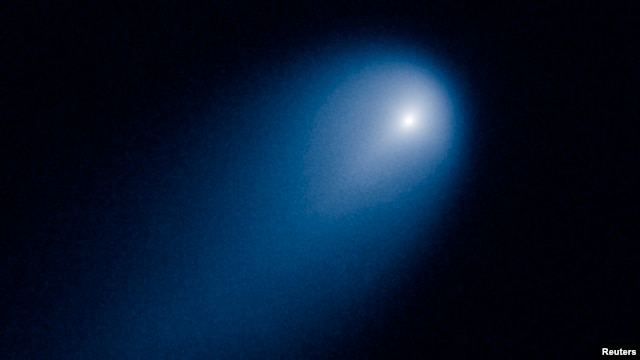bitterlyclingin
Silver Member
- Aug 4, 2011
- 3,122
- 425
- 98
[Whether it will be Civil War here against Barack Obama or Iran's nuking Israel remains to be seen? November's the time, though. However, if I were the Devil scheduling my next war, I'd start it on Christmas Day, just to be malevolent and nasty like this state's DCF never missing a chance to twist the knife blade around a little after first plunging it into its victim.]
"A NASA spacecraft has captured its first photos of comet ISON, an icy wanderer that some scientists say could dazzle as a "comet of the century" when it swings through the inner solar system later this year.
The photos were taken by NASA's Deep Impact probe and reveal comet ISON as a bright, dusty ball moving against a star-filled background. The spacecraft snapped the pictures on Jan. 17 and Jan. 18 from a distance of about 493 million miles (793 million kilometers).
Comet ISON has been the focus of much anticipation among scientists and stargazers because of its potential to put on a spectacular display in late November, when it makes its closest approach to the sun. Some forecasts predict the comet could shine brighter than the full moon. As of mid-January, the comet's tail was more than 40,000 miles (64,400 km).
Will comet ISON sizzle or fizzle?
Some projections state that comet ISON, which is officially designated comet C/20012 S1 (ISON), could shine extremely bright in the nighttime sky, possibly even rivaling the full moon. Whether the comet will meet expectations or fizzle out remains to be seen, but it has already become a target for NASA and amateur astronomers. [Photos of Comet ISON in Night Sky]
"This is the fourth comet on which we have performed science observations and the farthest point from Earth from which we've tried to transmit data on a comet," Deep Impact project manager Tim Larson, of the agency's Jet Propulsion Laboratory in Pasadena, Calif., said in a statement Tuesday (Feb. 5) "The distance limits our bandwidth, so it's a little like communicating through a modem after being used to DSL. But we're going to coordinate our science collection and playback so we maximize our return on this potentially spectacular comet.""
NASA Probe Snaps Photos of Potential 'Comet of the Century' - Yahoo! News
[Oh, and BTW. On or about February 15th, this, a football field sized piece o rock is supposed to fly by the Earth at a distance of a mere 17,000 miles. Compared to the astronomers One Astronomical Unit measurement, 93 million miles, the distance from the Earth to the Sun, or the 232,000 miles separating the Earth from the Moon, 17,000 miles is a cat's whisker of a distance on the astronomical scale. Don't worry they tell us. Its not going to hit us, and even if it did, its not planet killer size, or species, or civilization killer size. It wouldn't even take out the entire United States. Iran, North Korea, Cuba, Venezuela, Illinois, New York, Maryland, Oregon, California, Massachusetts, Washington, Minnesota,...........would just about be the perfect size]
[Fergot New Jersey. Tunguska, here we come!]
"A NASA spacecraft has captured its first photos of comet ISON, an icy wanderer that some scientists say could dazzle as a "comet of the century" when it swings through the inner solar system later this year.
The photos were taken by NASA's Deep Impact probe and reveal comet ISON as a bright, dusty ball moving against a star-filled background. The spacecraft snapped the pictures on Jan. 17 and Jan. 18 from a distance of about 493 million miles (793 million kilometers).
Comet ISON has been the focus of much anticipation among scientists and stargazers because of its potential to put on a spectacular display in late November, when it makes its closest approach to the sun. Some forecasts predict the comet could shine brighter than the full moon. As of mid-January, the comet's tail was more than 40,000 miles (64,400 km).
Will comet ISON sizzle or fizzle?
Some projections state that comet ISON, which is officially designated comet C/20012 S1 (ISON), could shine extremely bright in the nighttime sky, possibly even rivaling the full moon. Whether the comet will meet expectations or fizzle out remains to be seen, but it has already become a target for NASA and amateur astronomers. [Photos of Comet ISON in Night Sky]
"This is the fourth comet on which we have performed science observations and the farthest point from Earth from which we've tried to transmit data on a comet," Deep Impact project manager Tim Larson, of the agency's Jet Propulsion Laboratory in Pasadena, Calif., said in a statement Tuesday (Feb. 5) "The distance limits our bandwidth, so it's a little like communicating through a modem after being used to DSL. But we're going to coordinate our science collection and playback so we maximize our return on this potentially spectacular comet.""
NASA Probe Snaps Photos of Potential 'Comet of the Century' - Yahoo! News
[Oh, and BTW. On or about February 15th, this, a football field sized piece o rock is supposed to fly by the Earth at a distance of a mere 17,000 miles. Compared to the astronomers One Astronomical Unit measurement, 93 million miles, the distance from the Earth to the Sun, or the 232,000 miles separating the Earth from the Moon, 17,000 miles is a cat's whisker of a distance on the astronomical scale. Don't worry they tell us. Its not going to hit us, and even if it did, its not planet killer size, or species, or civilization killer size. It wouldn't even take out the entire United States. Iran, North Korea, Cuba, Venezuela, Illinois, New York, Maryland, Oregon, California, Massachusetts, Washington, Minnesota,...........would just about be the perfect size]
[Fergot New Jersey. Tunguska, here we come!]





